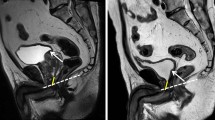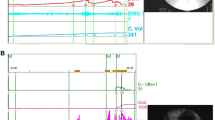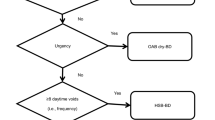Abstract
A group of 107 patients with lower urinary tract symptoms (LUTS) from benign prostatic enlargement (BPE) participated to the HOUSE Study (Home and Office Uroflowmetry Specific Evaluation). Patients received routine investigation, consisting of medical history taking, physical examination including digital rectal examination, prostate-specific antigen (PSA), assessment of symptoms listed both on the International Prostate Symptom Score and on ICS-male questionnaire. We examined the results of uroflowmetry evaluation in this population; data were analysed to observe if any circadian changes of parameters obtained with home uroflowmetry could be detected. We searched a correlation between Qmax, Qave and ICS-benign prostatic hyperplasia symptom score: a significantly inverse correlation was found only for Qmax, confirming Qmax as a reliable parameter to quantify subjective symptoms. When examining the multiple flow curves recorded in the same patient with home uroflowmetry, voided volume and flow time had usually higher values during night-time: the existence of circadian changes of uroflowmetry parameters in patients with LUTS from BPE was confirmed, and lower values of average and maximum flow rates during sleep hours were recorded in the same patient. In conclusion, when evaluating the natural history or treatment outcome of individual patients or group of patients in clinical trials for evaluation of BPE and LUTS, an assessment including multiple measurements may be useful and of value.
This is a preview of subscription content, access via your institution
Access options
Subscribe to this journal
Receive 4 print issues and online access
$259.00 per year
only $64.75 per issue
Buy this article
- Purchase on Springer Link
- Instant access to full article PDF
Prices may be subject to local taxes which are calculated during checkout

Similar content being viewed by others
References
De la Rosette JJMCH et al. Improved reliability of uroflowmetry investigations: results of a portable home-based uroflowmetry study. Br J Urol 1996; 78: 385–390.
Ezz el Din K et al. The correlation between bladder outlet obstruction and lower urinary tract symptoms as measured by the International Prostate Symptoms Score. J Urol 1996; 156: 1020–1025.
Golomb J et al. Variability and circadian changes in home uroflowmetry in patients with benign prostatic hyperplasia compared to normal controls. J Urol 1992; 147: 1044–1047.
Boci R et al. Home uroflowmetry: improved accuracy in outflow assessment. Neurourol Urodyn 1999; 18: 25–32.
Donovan JL et al. The ICS-BPH Study: the psychometric validity and reliability of the ICSmale questionnaire. Br J Urol 1996; 77: 554–562.
Siroky MB, Olsson CA, Krane RJ . The flow rate nomogram: I. Development. J Urol 1979; 122: 665–668.
Schäfer W . Analysis of bladder-outlet function with the linearized passive urethral resistance relation, linPURR, and a disease-specific approach for grading obstruction: from complex to simple. World J Urol 1995; 13: 47–58.
Meier AHP et al. Reliability of free uroflowmetry using repeated measurements of homeflowmetry in males. Neurourol Urodyn 1994; 13: 453–454.
Sonke GS et al. Low reproducibility of maximum urinary flow rate determined by portable flowmetry. Neurourol Urodyn 1999; 18: 183–191.
Blanker MH et al. Normal values and determinants of circadian urine production in older men: a population based study. J Urol 2002; 168 (4, Part1): 1453–1457.
Porru D et al. Urinary symptoms in women with gynaecologic disorders: the role of symptom evaluation and home uroflowmetry. Arch Esp Urol 1998; 51: 843–848.
Bosch JL et al. The International Prostate Symptom Score in a community-based sample of men between 55 and 74 years of age: prevalence and correlation of symptoms with age, prostate volume, flow rate and residual urine volume. Br J Urol 1995; 75: 622–630.
Larosa M et al. Uroflowmetry in the assessment of patients with benign prostatic hyperplasia in Italian men. Acta Biomed Ateneo Parmense 1999; 64: 17–22.
Jensen KM et al. Some clinical aspects of uroflowmetry in elderly males. A population survey. Scand J Urol Nephrol 1986; 20: 93–99.
Porru D et al. Relationship of flow rate with symptoms, quality of life and other clinical parameters in patients with LUTS suggestive of BPH. Eur Urol 2001; 40 (Suppl 1): 23–27.
Blanker MH et al. Voided volumes: normal values and relation to lower urinary tract symptoms in elderly men, a community-based study. Urology 2001; 57: 1093–1098.
Acknowledgements
This work was supported by an educational grant from Boehringer Ingelheim, Milan, Italy.
Author information
Authors and Affiliations
Consortia
Corresponding author
Rights and permissions
About this article
Cite this article
Porru, D., Scarpa, R., Prezioso, D. et al. Home and office uroflowmetry for evaluation of LUTS from benign prostatic enlargement. Prostate Cancer Prostatic Dis 8, 45–49 (2005). https://doi.org/10.1038/sj.pcan.4500763
Received:
Revised:
Accepted:
Published:
Issue Date:
DOI: https://doi.org/10.1038/sj.pcan.4500763
Keywords
This article is cited by
-
Diurnal differences in urine flow in healthy young men in a light-controlled environment: a randomized crossover design
Journal of Physiological Anthropology (2023)



